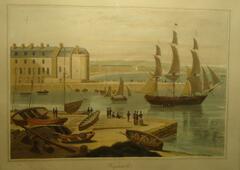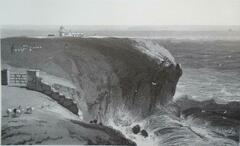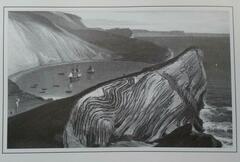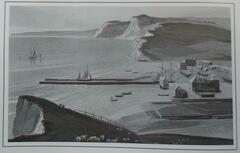Members may recognise this print of Weymouth harbour (and part of the WSC yard), though many will not know of its author, William Daniell RA (1769-1837), who in the years between 1813 and 1823 toured the coast of Great Britain producing views wherever he went, of which this is one.
Daniell started from Land’s End heading north, originally intending to sail, though ‘early attempts at sailing off the north coast of Cornwall proved disastrous’ and Daniell completed the journey on horseback, in a gig or on foot.
Weymouth was already on the map from 1789 thanks to George III’s visits and the ‘King’s statue’ had been erected in 1810 (the invoice for which can be inspected at the Dorset History Centre). Weymouth, it will be remembered by readers of Jane Austen, has a slightly daring quality in ‘Emma’ (1815), as the resort where Frank Churchill and Jane Fairfax have become secretly engaged. Here is what Daniell writes about the town a few years later to accompany his view:
“Weymouth is situated along the shore of a fine bay near the mouth of the little Wey*. The esplanade, which was originally a sort of mound formed by succesive accumulations of the rubbish of the town, is now one of the finest marine walks in England. The sands are smooth and firm, and the waters of the bay so well screened by the surrounding hills as to be comparatively tranquil even in boisterous weather. The air is particularly salubrious; and the various places of note in the environs offer the most agreeable incentive to exercise, either in a short or a lengthened excursion.”
While Daniell’s aquatint prints formed part of the growing industry producing generic ‘views’ for a middle-class public to hang on their walls, this view across the harbour merits closer attention. The scene shows one of those typical late mornings in summer when the sea breeze has yet to appear, and groups of spectators, among whom we might imagine Mr Churchill and Miss Fairfax, are standing in what is now our yard, watching a three-masted vessel slowly drift down towards the harbour entrance. The ship is on the port gybe, with only her main course not yet set, as she edges across to catch what breeze there is around the newly-finished Pulteney Buildings (c.1805), whose building must have considerably altered the ease of sailing into and out of the harbour!
The ship is interesting, in that it appears to be a brig with an extra mast, or possibly a ship-rigged sloop, of which a number were in naval service at the end of the 18th century, though this one does not appear to be a naval vessel. Daniell was a careful observer and was good at capturing details of the many boats which inevitably figure in his pictures of ports, and it is unlikely that he made a mistake, which leaves us with the fun of trying to guess what kind of ship it is.
Daniell also drew Lulworth Cove, Portland Bill and West Bay, of which I have included black and white versions from the book to consult - David Addey’s invaluable 'A Voyage Round Great Britain – Sheerness to Land’s End' (1995); for Weymouth’s history of this and any other period see 'Weymouth – An Illustrated History' by Maureen Attwooll and Jack West (1983).
* Daniell is distinguishing our Wey from the tributary of the Thames with the same name.
Steve Fraser
Submitted on 13th May 2020




